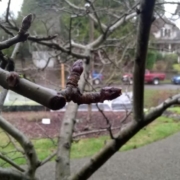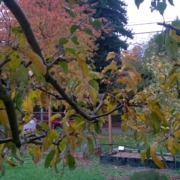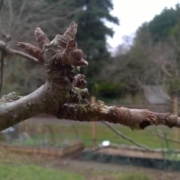December 14, 2023
The Williams’ Pride apple tree was developed by the Purdue, Rutgers, and Illinois (PRI) universities’ breeding program of the 1970s. It’s early to bloom and early to ripen. We enjoy these apples in August! This tree is disease resistant, cold hardy, and has a low chilling requirement. I watched the changes of the Pride’s flower buds and took photos each month. At the same time, I also noted some key accomplishments by our best-in-the-west volunteer team.
January
Warmth is what the bud is searching for now: about 360 Growing Degree Days (GDD) are needed for the William’s Pride fruit buds. Take the average temperature for a day and subtract 43 (43ºF). The excess is the GDD for that day.
Warmth is also what the volunteers are searching for. Warmth comes from projects like path weeding, shoring up garden bed frames, pruning, and pumping water up to the elevated barrels.
February
The bud is ready to begin its performance. Down below, roots, unlike other tree parts, are resting but ready. If soil temperatures are above freezing, winter roots can become active.
Firmly rooted in the muck are any volunteers working in the northwest part of the orchard. Vegetable starts for spring planting are in the making. Supplies are ordered: row cover, slug bait, straw, seeds, plant pots, and potting soil, etc.
March
 Buds are quickly developing and will soon reach the ‘green tip’ stage, the signal that any pruning should cease.
Buds are quickly developing and will soon reach the ‘green tip’ stage, the signal that any pruning should cease.
The green tips of cover crops are sliced and diced and added to the garden beds. Cool weather vegetable starts are hardening off for the annual Spring Plant Sale. We scrounge for cedar, rubble, hardware cloth and bamboo.
April
 And thar she be! Pretty, pink and plump. Flower blossoms will open any day and lure the varied species of pollinators.
And thar she be! Pretty, pink and plump. Flower blossoms will open any day and lure the varied species of pollinators.
Helpers with pretty pink cheeks plant plump lettuce. Some contribute time to the 60th St restoration project. They also weed whack the grass and blow debris from the path and cistern areas.
May
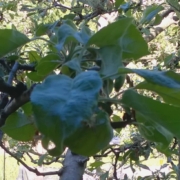 Just after petal fall. Just prior to fruit set. The busy tree pushes out new roots.
Just after petal fall. Just prior to fruit set. The busy tree pushes out new roots.
The crew puts the petal to the metal, planting hot weather crops and setting trellising structures. They install barriers against pests, including coddling moth and maggot fly, squirrels, rats and rabbits. Our vandalized city faucet is rebuilt. The the long season of watering begins.
June
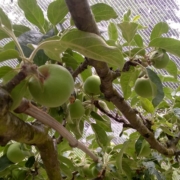 Oops. Pruned off the branch I was photographing. New branch. Next year’s fruit buds are initiated. Fruit, shoot and leaf growth are intense.
Oops. Pruned off the branch I was photographing. New branch. Next year’s fruit buds are initiated. Fruit, shoot and leaf growth are intense.
Insects are initiated also. The chard is debugged and leafroller larvae dislodged. Wood trim of garden beds is washed and stained. The harvests are plentiful and biked off to the food bank. Sheet mulching and mowing with the scythe are needed. Milk spray is applied to grapes and the William’s Pride tree to ward off powdery mildew. Water.
July
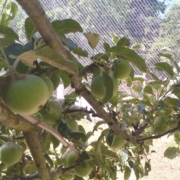 The apples are getting large and some are just starting to color. Next year’s fruit buds are quietly developing.
The apples are getting large and some are just starting to color. Next year’s fruit buds are quietly developing.
KidsCo kids are also getting large and are unquietly developing. They help with watering and construct bamboo structures. Harvest garlic for curing. Pick blueberries for kids and volunteers. Prune trees and shrubs. Website updates, accounting, posting volunteer time. Water.
September
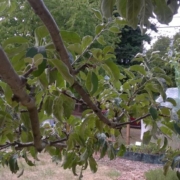 Completion of bud set for next year’s fruit. The tree is finished with its hardest work.
Completion of bud set for next year’s fruit. The tree is finished with its hardest work.
Volunteers are also finished with their hardest work. The harvest crew celebrates. Inspect fruit for insect damage. Harvest grapes and Honeycrisp. Pick up apple drops. Water. Rain on September 20. Hurrah!!
October
Leaves are falling and the tree shows no signs of growth. Dormancy reaches its maximum level. Dormancy is protective; warm weather can’t force the tree into growth.
Gardeners pass on the dormancy idea and busy themselves harvesting fruit, potting up plants and sprucing up the garden for our annual Cider Fest.
November
Dormancy breaks slowly as the new bud counts Chilling Hours – hours when the temperature is between 32F and 45F. These accumulated hours are docked for hours exceeding 60ºF.
Aliums are planted and prunings become ‘green manure’ for the fall thermal compost. The last of the persimmon are handed out. A garry oak is planted in the native plant garden. Zoo Doo is hauled to the orchard.
December
The necessary 500 chilling hours will be met by the end of December. The new buds send up their antenna to sense the warm spring temperatures necessary for growth.
Chilling hours are also put in by volunteers. Donning hats and boots, there is still more cleanup and fences need building or mending. Propagation by seed or by cuttings begins. Cistern gutters and filters are cleaned. Gifts await the 2023 FECO 20-hour club!
I guess you could call this the executive summary of FECO’s 2023 annual report!
Ruth
Special thanks to Erin Sonntag for her amazing website skills.

